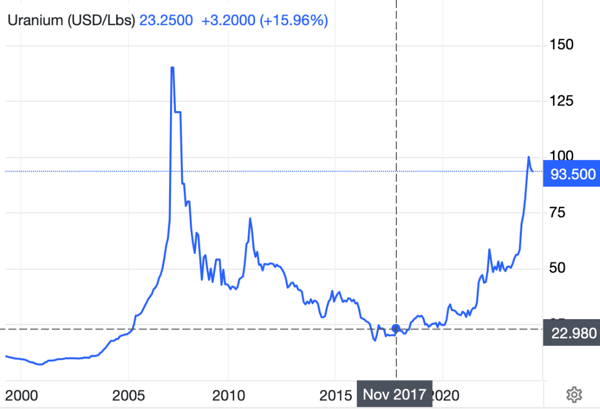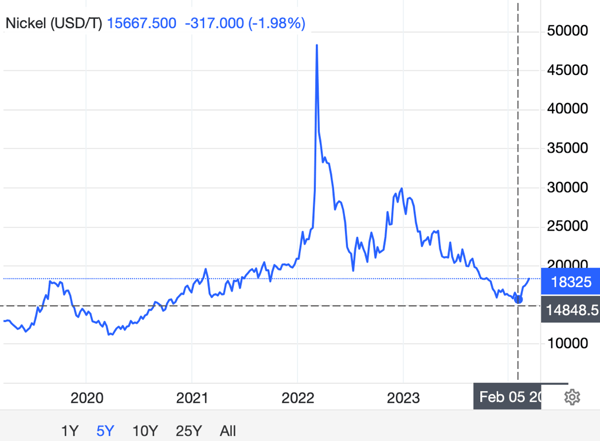Nickel today is reminiscent of uranium of 2017, back when uranium was on its knees, the market was deeply bearish, and major producers were shutting down. Yet 2017 also marked the start of uranium’s ongoing bull market that has sent most uranium stocks up ten-fold or more. We ask here whether nickel might be about to follow the same script and look at one nickel junior that’s well set to leverage such a move.
In late 2017, uranium had been in a 10-year bear market that had seen the spot price fall more than 80%. After a decade of false dawns, investors had given up and the mood in the sector had gone past pessimism and into apathy.
This hadn’t been helped by Kazakhstan, which more than tripled uranium production from 17 million pounds in 2007, to 55Mlb in 2016. This was one factor weighing on prices, and with major producers making a loss, something had to give. In November 2017, Cameco, the second largest producer globally, told the market:
“With the continued state of oversupply in the uranium market and no expectation of change on the immediate horizon, it does not make economic sense for us to continue producing at McArthur River and Key Lake.”
Cameco suspended operations, laid off hundreds of staff, and bunkered down for better times. Obviously, it was bad news for investors and a terrible outcome for the company’s workforce. A few months later the Kazakhs cut their production 20% as well.
A supply destruction response like this can be a classic signal of the bottom of the commodity cycle. Within a few months, spot uranium started the most ignored bull market in history, which over the past six years, has taken it from ~US$23/lb at the time of the Cameco closures, to recently trade north of US$100/lb, before pulling back in recent weeks.

Source: Trading Economics
Additional fundamentals have since piled on to drive this, including growing government support for nuclear by most developed economies, supply issues by the majors, and loose inventory being sequestered by funds. The whole thing is a heady mixture for a sustained deficit, but the starting pistol was that supply destruction when Cameco closed shop.
It’s worth noting that Tribeca’s Nuclear Energy Opportunities fund opened its doors just six months after the Cameco news, in mid-2018. Portfolio Manager Guy Keller often tells the story of how one broker said NEO would be the shortest-lived fund in history. However, Keller’s had the last laugh as he nailed the timing and the call, with the fund averaging +40% p.a. in the six years since then.
So how does this all compare with today’s nickel market?
Firstly, the nickel price has also fallen dramatically in recent years. While not as drawn out as the decade-long uranium bear market, nickel has still fallen more than 70% from its dramatic spike in early 2022.
And as with uranium in 2017, the market had been turned on its head by a new entrant rapidly growing market share with cheap production. This time, it is Indonesia which has roughly tripled nickel production in just five years, to dominate the market.
This growing oversupply has whacked prices, and just as with Cameco in 2017, numerous Western nickel producers have become unprofitable and recently suspended operations.
As a result, today’s sentiment toward nickel is also deeply bearish. Most investors would prefer a root canal than hear a nickel story, with a typical response being ‘why would I invest in a nickel junior when even Twiggy’s shutting shop?’
It certainly takes some conviction to invest in a market like this, but seeing the majors shut down was what rang the bell for the bottom of uranium cycle and set the clock ticking on the uranium thematic that is still playing out 6 years later.
It’s looking as though nickel’s resurgence may have even kicked off already, gaining more than 17% in the last month.

Source: Trading Economics
One swallow does not make a summer of course, but so far, we are following the uranium script, so it could be time to rummage through the bargain bins and add some nickel juniors to the watchlist.
While Indonesia has invested in additional production that would create further headwinds to prices, anyone that has ever invested in an aspiring producer will tell you that when building a mine, just occasionally things don’t go 100% to plan. So many assumptions are baked into the Indonesian production forecasts, yet any number of other issues could yet surface, and there are already rumblings about problems with permits.
Notably, Macquarie’s veteran ‘nickel man’, Jim Lennon, broke ranks with consensus to make some bullish comments last week, going as far as to say that based on his recent observations, the market could even swing into deficit this year.
Some investors have already started buying nickel equities, with a few names ticking higher, or at least forming a base, in recent weeks.
Aston Minerals (ASO) is one nickel junior that offers some real leverage to a higher nickel price, firstly given the >90% fall in its share price during the two-year nickel bear market, but mostly through the scale, metallurgy, and location of its asset, and all-star board and management teams.
While Aston’s share price was getting pummeled by the nickel market, the company defined a monster, billion-tonne nickel resource in the heart of nickel country in Ontario, Canada. The project it is surrounded by all the infrastructure you could ever hope for to build and run a mine. The resource’s mineralisation is disseminated and very consistent, and the company is defining a shell for an open pit, with Colin Hay recently updating The Pick on Aston’s near surface drill results supporting this.
Aston’s MD Russell Bradford is a metallurgist with 30 years’ experience and has been focused on proving the metallurgy stacks up, with recent releases pointing to it being excellent. Bradford was brought in to take the reins last year by directors Tolga Kumova and Rob Jewson, having worked previously with chairman Peter Breese and Aston’s management team on major successful companies such as LionOre, Mantra and Asanko.
With cash in the bank, a beaten-up share price, and the trifecta of project, team, and location, Aston seems like an obvious pick to play a nascent nickel bull market, something that may have even started already.





